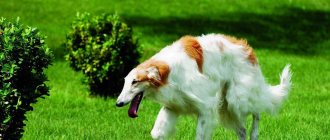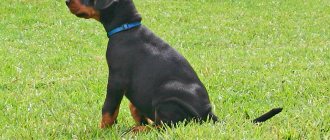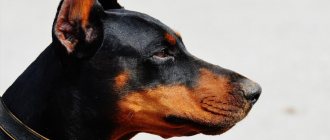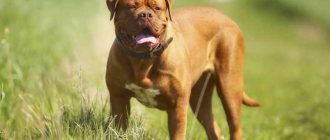History of the breed
As far as we know, by the middle of the 19th century, a man who was in the public service of the German Principality of Thuringia - Mr. Friedrich Louis Dobermann, who also earned money by catching stray animals and keeping them in a shelter, came up with the idea of bringing a new breed that would be fearless, vicious, strong and have special endurance , was especially helpful and devoted to the owner.
According to one version, the goal was to breed a fighting breed of dogs. However, lovers of this breed refute this version and claim that Friedrich Dobermann wanted to breed a breed that would be an ideal guard for the owner.
First of all, intoxicated by the goal, Friedrich Dobermann visited all kinds of fairs in his hometown of Apolda. At one of these events, a pair of Old German Pinschers was purchased, which subsequently reproduced the Bismarck bitch, which was used in further reproduction.
These few factors are known for certain, since they are included in almost all reference books on dog breeding. Possible ancestors of the Doberman breed also include herding dogs and the Greyhound, Blue Great Dane, Manchester Terrier, and Butcher Black and Tan.
The breed was developed by a German official named Friedrich Louis Dobermann. He worked for the state, collecting taxes from the population. For his image and to suit his position, he needed a spectacular dog with a menacing and intimidating look.
Then he began selection work to develop a new breed, although he had never done such things before and did not have the necessary experience. Dobermann took the organization of the experiment seriously: he bought a house, created all the conditions for the future nursery and attracted knowledgeable people to the matter. The result of painstaking work was the appearance of a bold and courageous dog with a terrifying appearance. Representatives of the new breed began to serve in the city patrol. In 1860, residents of Apolda could already purchase a puppy at the fair.
Friedrich Dobermann himself called the new breed the “Thürring Pinscher,” but in 1894 it was renamed in honor of the creator, who had already left this world. The breed began to be called the “Doberman Pinscher,” but fifty-five years after the standard was changed, the “pinscher” prefix was removed. This term indicates membership in the group of rat catchers, but this characteristic has nothing to do with the Doberman.
History of the breed
The Doberman Pinscher is a young breed. It began to take shape in the 70s of the XIX century. But exact data about its origin has not been preserved.
This is the only German breed named after its creator. Its founder, Friedrich Louis Dauberman, worked as a tax collector and policeman.
He also had to deal with stray dogs.
All this influenced the decision to create an alert, extremely hardy and courageous dog with well-developed working qualities as a guard and house dog.
This is how the Doberman Pinscher appeared; the Miniature Pinscher became its prototype. This little dog inspired Friedrich to create an enlarged copy of it.
The breeder did not keep any records of his work. All modern versions of the origin of the Doberman are just guesses.
Dobermans are not just working dogs, they are also excellent companions. These are noble animals with a hot character. They are recklessly loyal to their owners, alert and energetic.
There is reason to believe that the ancestors of the Old German Pinscher, Beauceron , and Rottweiler were used to consolidate the necessary qualities.
There was also some admixture of the blood of a black and tan terrier, Great Dane, Greyhound , Setter , and Pointer.
Either Friedrich Doberman was a genetic genius, or he was just lucky, but as a result of such crossings, the Doberman Pinscher breed, ideal for protection and detection, was born.
Description
A representative is easy to recognize by his appearance. Males reach a height of sixty-eight to seventy-two centimeters, and females - from sixty-three to sixty-eight.
Weight ranges from thirty-two to forty-five kilograms and depends on gender. Males appear particularly tall and massive, while females appear slender and compact. There are the following color variations: black with red tan and brown with orange-red tan.
Breed standards:
- a powerful jaw is characterized by the presence of strong white teeth that meet in the correct bite;
- the wide muzzle is not pointed;
- strong physique takes the shape of a rectangle;
- the elongated neck is equipped with muscles;
- the chest protrudes in all directions, the stomach is tucked in;
- The coat is short and lies close to the body. There is no undercoat.
Breed standard
Dobermans are honorably recognized as the most beautiful of all breeds of dogs for this purpose. Strong, hardy, stately, smart, long-legged - they include all the advantages of the breed. The graceful elongated muzzle evokes affection. Proud posture combined with an elegant physique and wide chest shows ideal anatomical proportions.
We suggest you read: Industrial quail breeding
The official Dobermann breed standard was approved in 1990.
The height at the withers for males is usually from 68 to 72 cm with a weight of 40-50 kg. Females are slightly smaller (63 - 68 cm with a weight of 32-35 kg).
The dog body has a square forum. Its length should not exceed the height at the withers by more than 5% (relevant for male dogs).
The skull is strong and appears proportional to the rest of the body. If you look at the line of the head from above, it will resemble a rounded wedge.
The stop is well defined.
The muzzle is wide and deep. The lips fit tightly to the teeth. Scissor bite, powerful jaws.
The nose is large, black in black and tan dogs and brown in brown and tan dogs.
The eyes are most often dark and medium in size. Dogs that are not black may have lighter shades of the iris.
Ears were previously cropped; at the moment, cropping is prohibited by a large number of countries and cynological organizations. However, if the ears are cropped, they should be positioned strictly vertically on the head. If the ears have not been cropped, then the edge of the ear should touch the cheeks.
Is there a difference in the attitude of a bitch and a dog towards children?
There is a difference between Dobermans of different sexes in relation to children:
- Bitches have more maternal instinct. She will accept any child, will play with him, even lick him, and will never leave him alone, crying or upset. At the same time, she may mistake the child for her puppy. In this case, you need to be as careful as possible and show the dog that the baby is yours and hers. Otherwise, you may run into aggression from the female;
- Males are more freedom-loving. They like to play with the baby, they will not allow him to run into danger, but they are more passive. The male can simply lie for a long time and allow the child to do whatever he wants with him.
All dogs are individual, their behavior may not converge . A male dog may suddenly be even more attentive and loving than a female dog.
Character
There are negative rumors and opinions surrounding the breed. Many people believe that Dobermans are angry and aggressive. The first representatives were intended for protection, therefore they were decisive and courageous, ready to rush to the defense of the owner at any moment. However, they took any action only after a command, being very obedient.
Modern representatives are distinguished by high intelligence, extraordinary loyalty and obedience.
If necessary, the Doberman will definitely come to the defense of the owner and his family members, but will not show aggression unnecessarily.
Loyalty is a quality that any breed possesses, but the loyalty of Dobermans is of particular value. They are unconditionally loyal to one owner throughout their lives. Dogs are sociable and love to be around people. Representatives of the breed are happy to lie on the master's bed or on his lap.
A pet that has grown up with one owner since childhood is unquestioningly devoted only to him. Animals that spend their entire lives among several family members treat each of them tenderly. Loneliness has a negative impact on the pet’s condition: it begins to get bored and may even fall into a depressive state.
Dobermans cannot stand scandals in the house. Screaming and an unstable environment can even affect physical health and provoke illness.
Early representatives of the breed, which served as guards, were more aggressive than modern ones. Today's people are calmer and more balanced than their ancestors. The dog is wary of strangers and does not trust. A properly raised puppy will not show aggressive behavior without a command. However, you shouldn’t expect affection towards strangers from him either.
The breed is not only famous for its high intelligence, but is also valued for its easy trainability. In various ratings, she is among the top five in terms of trainability and obedience. Pets will complete any task for the sake of their owner and treats. Competent training, desire and effort of the owner will lead to a well-mannered and intelligent dog.
You can’t put pressure or use force on her. She is afraid of swearing, gets offended and may begin to defend herself. The best qualities that an owner must show are calmness, consistency and firmness of intentions. He must be respected by the pet, otherwise an excellent tandem will not work out.
Dobermans were created as guard dogs that must accompany their owner on foot. For this reason, the owner must provide them with physical activity combined with interesting activities. Daily hour-long walks, full of running or training, will completely satisfy the need. If you don’t give the energy an outlet, the pet will find a way to satisfy the need on its own. He can ruin things and make a mess in the apartment. To avoid this, the owner must take care of the pet.
We suggest you read: Doberman breed characteristics: how much does a Doberman puppy cost, Doberman breed description, breed standard
Many people talk about the aggressiveness of Dobermans. An image was created of evil dogs that tear apart everyone and everything if they are not in a good mood. It cannot be said that these animals are absolutely harmless souls, but one cannot talk about their immeasurable cruelty. They are much kinder and more flexible than fighting dogs.
If earlier Dobermans were indeed more aggressive and ferocious, then modern representatives of the breed are peaceful, getting along well with people. They never take advantage of the weakness of others, so you don’t have to worry about the dog knocking your baby down or snatching a treat out of your hands.
The Doberman will be respectful not only of the owner, but also of the rest of the family, including other pets. He gets along well with children and will never offend them.
How to treat children
In relation to children, the Doberman is an extremely friendly dog. He will always happily accept the arrival of a new family member and will love him no less than his owner.
Many Doberman owners note how tenderly the breed treats children.
Dogs quickly become attached to babies and love to play with them. It is noteworthy that the dog understands the child’s weakness and insecurity in relation to the world and to himself.
For this reason, Dobermans strive to protect the baby from any external factors, and in games he is patient and can endure attacks from children for a long time, such as pulling the ears, tail, or playing horse.
But don’t think that the Doberman’s patience is limitless. He, like any creature, also experiences pain, so he can snap or growl sharply, warning .
And any smart and responsible parents will always stop the child’s bullying attitude towards their pet.
It is worth concluding that this breed is supportive, patient and loving towards younger family members. She will always come to their defense, entertain them with games, share some prank or calm them down. For kids, the Doberman will be an excellent, loyal and loving friend.
It is worth remembering that we are only talking about those dogs that were raised correctly and appropriately . If you have never trained and behaved your Doberman, then he can behave completely unpredictably.
Kozhevin Semyon Kirillovich
“A Doberman for children is a good choice, as long as you do not transfer the full responsibility of the nanny to him. We must remember that a dog has its own needs, including mental and physical, and a child, especially a small one, will not always be able to satisfy these needs. A dog will never hurt your son or daughter, but you won’t spend all your time with them either.”
Maintenance and care
Dobermans are beautiful and very easy to keep. They are unpretentious and shed little, so brushing them once a week is enough. To maintain the beauty and cleanliness of their coat, you do not need to bathe them often. This can only cause harm, as the protective layer of the skin will be damaged. It is enough to carry out water procedures several times a year. The rest of the time, give preference to wiping your pet with a damp towel.
Pay special attention to the animal's ears. Inspect them to notice possible inflammation and irritation in time. Do not use cotton wool to clean your ears. A soft cloth tampon is more suitable. Treat the ears only with the solution prescribed by the veterinarian.
Ideally, teeth should be brushed every day, or at most every week. Don't forget about trimming your nails. This should be done about once a month or as needed.
Attitude towards children and animals
Dobermans are good with children. A properly raised puppy will become a true friend for a child. He behaves calmly and peacefully with children, and if a child needs protection, the pet will save a small family member at the cost of his life. However, the child needs to be explained the rules of behavior and handling of the dog.
It is impossible to say for sure how a Doberman will interact with other pets. There may be a wonderful relationship, but there may also be rejection. For the most part, representatives of the breed have a positive attitude towards other pets. However, improper training can lead to severe aggression towards other pets.
This is especially true for relationships between male dogs, as they try to take a leading position. The attitude of the Doberman towards dogs and cats depends on the owner. If the owner has introduced him to other animals since childhood, he will be calm towards his four-legged neighbors. The hunter's instinct is poorly developed among representatives of the breed, so Dobermans consider the cats that live with them to be members of the family and take them under their protection. On the other hand, the Doberman is a large and strong dog that can make short work of a cat.
Doberman's temperament towards children
Dobermans are not worth a dog. And although a well-mannered representative of the breed is able to obey even a child, such behavior is achieved through titanic efforts on the part of the owner.
It is not recommended to leave a Doberman alone with a small child. These dogs have a labile psyche and are able to instantly switch from the “patience, only patience” mode to the “strict teacher” mode.
Representatives of the breed most often either openly avoid or tolerate other people’s children, but communicating with them does not bring pleasure to the dog.
Teach your child how to interact with a dog correctly. Do not disturb your pet while sleeping or eating. If a dog wants privacy, under no circumstances should you chase it or try to restrain it by force.
Health
Allergies. Dogs can suffer from allergies to mold, pollen and dust.
We suggest you read: Causes of allergies to cats or cat symptoms in children and adults
Heart diseases. An animal can be affected by coronary heart disease, tachycardia, heart failure, arrhythmia, etc. Health problems can be recognized by noisy and prolonged inhalations, difficulty breathing, loss of balance, and trembling.
Joint dysplasia (especially hip dysplasia) is a typical joint disease in large breed dogs.
Narcolepsy is a disease of the central nervous system in which a dog's sleep and muscle tone are disturbed. The animal becomes motionless, its eyes seem to be glass. This state can last a few moments or several minutes.
Gastric volvulus. This disease can be hereditary and develop as a result of poor nutrition.
Hypothyroidism is possible, but not common. If it occurs, it is accompanied by hair loss, weight gain or loss.
Sometimes Dobermans have congenital deafness or develop arachnoid cysts, cataracts, cancer, pathologies of the cervical vertebrae, and chronic hepatitis.
In order to prevent serious problems in the dog’s health, at the slightest alarming symptoms it should be shown to a veterinarian. Periodic preventative examinations will also not hurt.
Owner reviews
Vladimir. Krasnodar. I have had a Doberman for a very long time. The dog is amazing, however, it requires full dedication. I spend a lot of time walking and exercising with my pet. Before purchasing, I carefully studied all available information about the breed. You can’t get a dog without knowing the breed characteristics.
Anna. Ufa. My husband loves Dobermans very much, so these dogs always lived at home. They are very smart and loyal, they adore their owner and always make sure that he is not in danger. I really want to get a cat, but, unfortunately, I can’t do it because our Doberman can’t stand cats.
Training and education
Doberman dogs are serious, intelligent and true intellectuals. Thanks to their innate intelligence, these animals learn quickly. This fact must be taken into account from the first moments of the appearance of a Doberman puppy in your home and methodically, patiently and calmly raise your pet.
When the dog becomes attached to the owner and begins to unquestioningly recognize his authority, further obedience is practically guaranteed. Consistently accustom your pet to you, your family, and the world around you.
From an early age, take him for walks in busy places, or take him by car. He must get used to noise and different atmospheres, otherwise an older dog, not familiar with various aspects of human life, may behave inappropriately in an unusual environment.
Pros and cons of the breed
- ideal guard, companion and tracker;
- smart, quick-witted, well trained;
- are sincerely attached to the owner and family members, love them;
- easy to care for;
- sociable, get along well with children;
- external elegance and ideal body parameters.
As for the downsides, these dogs can be vicious and aggressive. They are intolerant of unfamiliar dogs. However, given proper upbringing and adequate training, such manifestations are rare.
How will he react to the new family member?
As already mentioned, Dobermans are very sensitive. They will always feel the owner’s emotions towards any person and will adopt them. This also applies to new family members.
In general, the reaction of this breed to the birth of a new person is very positive..
The introduction must be carried out carefully, talking to the dog, saying that he has a younger brother or sister, who now needs to be loved and protected. The Doberman will be curious about the new family member and will sniff him.
If this stage was successful, then you can be sure that no further problems will arise. But basically, they don’t arise, because this breed is very smart and understanding.











